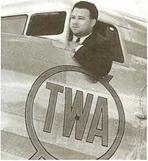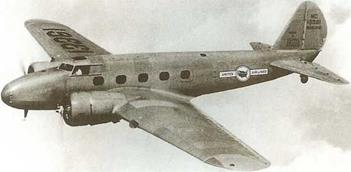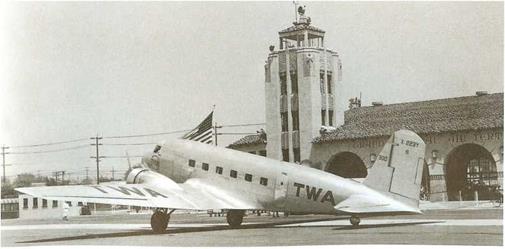Historic Prototype
The World’s First Modern Airliner
In 1933, the Boeing Aircraft Company had produced a twin – engined aircraft that most authorities, notably Britain’s Peter W. Brooks, considered to be the world’s first modern airliner, in that its monocoque fuselage and stressed skin wing, partially retractable landing gear, engines faired into the wing, together with other improvements, marked a big technical advance over the steel framework and heavy wing spar design of aircraft like the Ford Tri-Motor. The resultant superior aerodynamics gave the Boeing 247 a 60% speed improvement over the Ford, reducing the transcontinental flying time to about 18 hours, or less than a day.
|
TRANSCOnYiNENTAL a WESTERN AlR INC |
|
General Performance Specifications |
|
1Xtt* All metal trlnotored oonoplane preferred but combination structure or biplane would be considered. Mo. in internal structure mist be natal. Power» Three engines of 500 to 650 h. p. (Wasps with 1Э-1 auperohmxgerj 6*1 compression O. K.), |

|
lao be made for oomplate instruments, _ Г~Гlying equipment, fuel oapaoity for oruiaiag range of 1000 miles at ISO a. p.h., orew of two, at leaat 12 pee – aengera with oomfortabie aaata and ample room, and the usual mieoallaneoua equipment oerried on a passenger plane of this type. Payload should be at leaat 2,300 lba. with full equip* sent and fuel for maxtixim range. Perfonamnce Top (peed tea level (minimus) 185 a. p.h. Cruising speed aea level – 79 % top apeed 148 o. p.h. plus і-єга-и ng apeed not more than 65 a. p.h. Rate of olloh aea level (mlnlnaim) 1200 ft. p. a. Barrios celling (minimus) 21000 ft. Serwioe oelling any two engines 10000 ft. |
|
Transcontinental & Western Air ii interested in purchasing tan or eore trlaotorad tram port plena*. X ta ettaohlng our general perforaenee ipeolflcatlont, ooTorlng this equipment and would appreciate your a d ті * і ng whether your Company la interested in thla mamif soturing Job. If ao, approximately how long would It take to turn out the Гіг at plane for service teataT |
|
Vary truly youra, |
|
The Jock Frye Letter At the time (before the Black-McKellar Air Mail Act of 1934) aircraft manufacturers were allowed to own airlines, and Boeing Air Transport had been the foundation of United Air Lines. When Jack Frye wanted to place an order for the superior 247, he was politely told that United had booked the first 60 aircraft off the line, and that he would have to wait. Frye’s exact reaction is not recorded; but it did result in a letter which he circulated to five other manufacturers, in which he set out a specification for a tri-motor that, in effect, was ten percent better than the 247 in every respect: size, speed, airfield performance, and comfort. His wish was granted. The Douglas Aircraft Company, of Santa Monica, California, not only met all the requirements, but did so with a twin-engined design that eliminated the shortcomings of the fuselage-mounted center engine: noise, vibration, and pilot visibility. |
|
Jack Frye’s role in specifying |
|
Thia plane, fully loaded, oajst melee satisfactory telce-offs under good oontrol at any TWA airport on any combination of two angina a. |
|
jt/os |
|
Please oonaider thia inforamtion confidential and return ipeolfioatIona if you are not interested. |
|
Aeneas City, Missouri. August 2nd, 1932 |
|
This is a copy of the two-page “Jack Frye Letter” that laid down the specification for the aircraft that emerged as the first of the Douglas twin-engined series, DC-1, DC-2, and DC-3. It changed the course of airline history. |
|
This photograph, of the Douglas DC-1 at the Grand Central Air Terminal, Glendale, epitomizes the maturing air transport industry in the United States. T. W.A. ’s line of twin-engined Douglases eclipsed all others for a decade. |
|
The Boeing 247 was the first passenger transport airplane that could be described as a modern |













